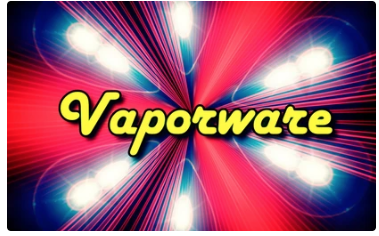Creating a demand for something you can’t deliver will hurt your brand reputation and your bottom line.
Make sure your product is ready.
You have nothing to sell until your product is complete. It sounds basic, but too many companies rush to launch while they’re still working out a fundamental issues with their actual offerings. Don’t invest marketing time and resources until you have a product you’re proud to announce to the public — a product you’re confident won’t break. Make certain you’ve taken it through a quality-control process. You get only one chance to make a favorable first impression. A minimum viable product (MVP) is quite fine. You don’t need all the bells and whistles to start. Just remember the key word: viable. Your product must be good enough to satisfy a customer’s need and solve (at the core) a major pain point in your market.
Vapor-where?
Vaporware is the name for software that doesn’t exist outside of a sales pitch or the imaginative spin of a marketing team. It’s software announced to the public or promised to a prospective client, but never actually produced, nor officially cancelled.
The causes of vaporware
More often, vaporware grows from an existing product. It’s a feature that doesn’t exist or a promise that the product can handle problems that it can’t.
One of the most common reasons to weave vaporware is the fear of losing a prospective customer or client. This fear can come from a host of other reasons. For example, the sales team needs to meet their quota, or the marketing team needs to keep up with the view of a competitive edge.
It’s all too easy to stretch the functionality of a feature to solve the extra pain for a nearly-converted customer, just to complete the sale. Easier still is letting a customer believe that the software does something that it doesn’t do. They conclude that feature A will solve problem Y, and they’re never told otherwise. It’s a ‘they didn’t say we couldn’t’ mentality.
The problems with vaporware
Unfortunately, vaporware can cause a lot of problems. It negatively affects the customer, the development team, and the company as a whole.
From a development perspective, vaporware promises time that the team doesn’t have. Busy dev teams suffer from extra stress as they not only have to meet the deadlines for their planned work, but also attempt to deliver on the promises of sold vaporware.
This often results in resentment between teams. Salespeople feel that developers are making them appear stupid; development teams feel a lack of respect for their time and opinions.
Worse still, promises of vaporware let the customer down. They feel cheated when they don’t get the features or functions promised. And it probably wasn’t worth the lie. Vaporware customers have a low lifetime value, as they’ll likely leave for a competitor after you misled them.
Vaporware can also damage company credibility.
Sometimes this is intentional, done by various promoters and stockholders solely to drive up the company’s share prices, lure in new investors, or create a buzz in the marketplace that will keep their name on top. In the most extreme cases, the developing company itself may be a total fraud. That said, the vast majority of vaporware isn’t malicious. Most of the time there is a legitimate product being produced, but internal problems simply result in it falling behind schedule and being passed in the marketplace by competitors. The developers simply promised more than their programmers could possibly deliver in too short a time frame.
Overall, vaporware in healthcare can undermine trust, waste resources, impede progress, and create false hope, all of which are detrimental to the goal of improving patient care and outcomes. It is important for developers and organizations to ensure transparency and responsible communication when announcing new technologies to avoid these negative effects.


Recent Comments